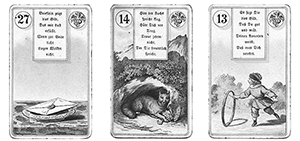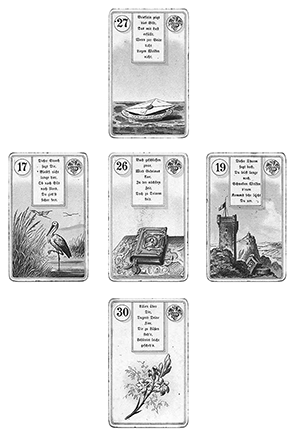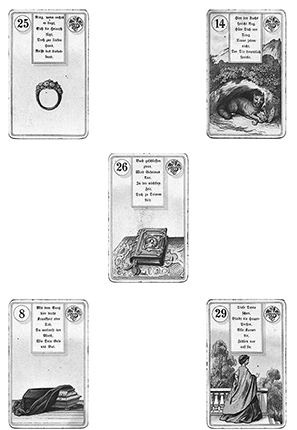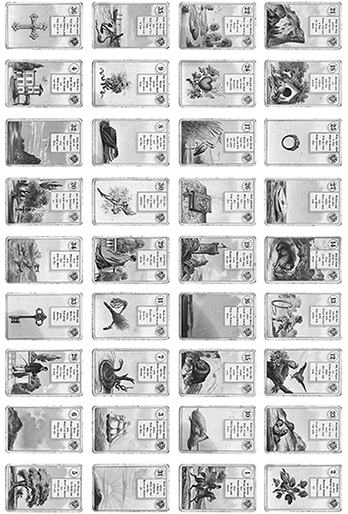The Grand Tableau
A reading that you see in front of you may appear wildly improbable,
and totally at variance with what you know of your consultant. Pay no heed
to this. Your business is to read exactly what you see. Simply that and
nothing more … The cards know a great deal more than you do. There is
always something fresh to be learnt from each “fortune” you read.
—Cicely Kent, Telling Fortunes by Cards
We will now introduce the Grand Tableau, which you may be surprised to find that you now know how to read using the skills we have covered in our previous chapters. Though it will take practice, you have the essentials already in your head, so let’s apply them.
Simpler Layouts
Leading to the Grand Tableau
We have seen that the Grand Tableau can be laid out in at least two or three different manners, so we will continue to keep things simple with the 9 x 4 layout. However, before we start, we will look at some simpler layouts, starting with the 3 x 1 three-card layout.
We also need to introduce the idea of “charged cards” now—that is, cards that act as compass points, about which we navigate and find our bearings. These are somewhat similar to the significator in a tarot spread, but they’re different enough to require explanation.
A charged card is taken out of the deck by choice to relate to the question being asked. In general cases, this is the Gentleman card for a male sitter and the Lady card for a female sitter. In other specific instances, the card is chosen according to one’s correspondences and keywords. Here are some cards for you to consider.
|
Charged Cards (Key Cards) |
|
|
Relationship |
The Heart |
|
Health |
The Bear |
|
Spiritual Life |
The Coffin (sometimes used for immediate health issues) |
|
Career |
The Fox |
|
Home/Domestic |
The House |
|
Education |
The Book |
|
Contracts |
The Ring |
|
Relocation/Travel |
The Ship |
The appropriate card is first taken out of the deck and “charged” (in rune work we would call this “loading”) by concentrating on the card. There are various other actions one can take to charge the card, but they aren’t covered here and a moment of concentration will suffice.
The card is then replaced in the deck so we know what we are looking for when it is laid out with other cards in any form of layout. It provides a beacon for us to use in highlighting the tableau. Consider it a lighthouse, shining brightly on the cards around it (but perhaps missing those right next to it) and less brightly on the cards far away from it.
If we are performing a quick three-card spread, we simply shuffle and go through the deck face-up until we find the charged card. We select the card above it and below it, and lay these out together for our reading.
In any case of shuffling, you may wish the sitter to shuffle, or you may shuffle and allow the sitter to then split the deck into three piles (with their left hand) and then restack them into one deck.
Three-Card Reading (Career)
Let us imagine our sitter has asked about his or her career. We are to perform a three-card spread. We charge the Fox card, and then shuffle (or allow the sitter to shuffle) and perform a three-deck split. When the cards are placed back in a single pile, we turn them face-up and work through them carefully to locate the charged Fox card.
The card immediately above it, we place down on the table, then the Fox itself, then the card immediately below it. Of course, you can select two cards above and below for a five-card layout; three cards above and below for a seven-card layout; and so on.

Figure 63. Three-Card Career Reading
In this example, the Letter is to the left and the Child to the right of the Fox. Using our essence keywords, we see this as “an innocent sentiment.” As a sentiment is a combination of beliefs and emotions, we read this as being completely guileless with regard to career (the young child.) Unless this sitter is looking for employment in childcare or other related fields (for example, entertainment) this does not bode well for job-hunting.
The Letter itself may be read literally that the person will receive an offer but going into it wide-eyed is ill-advised, as otherwise they will be eaten. (The fox has caught the bird in the central image.) This is very much a warning.
Nine-Card Reading (Romance)
In this next reading, we look at a charged card for relationships, the Heart. Whilst generally we would look mainly at the placement and relationships between the Gentleman and the Lady cards for matters of romance, we can also look at the Heart card to see the sitter’s emotional state within the situation.
In this nine-card reading we have placed the heart at the centre of the cards for the purpose of teaching—this will make sense later in this lesson. For now, just work with us un moment and examine this layout.
Take a look at these cards in relationship to each other. One thing that immediately strikes us is that bearing down on the emotional state of the Heart (reading right to left) are the top three cards, together showing “a proposal of faithful reliability.” The sitter’s highest expectation of relationship is to be given a long-lasting statement of trust. When we look at the three cards below, we might see that they have reached a standstill in their self-appreciation (Anchor + Bouquet + Coffin), the Coffin doubly signifying a recent change of state (perhaps a divorce or other breakup) and also their self-initiation and image. With the Bouquet “appreciation” is turned into a self-image and self-worth state, rather than someone else’s appreciation.
We hope you can see how we must read the cards together first, in batches, sets, montages, vignettes, scenarios, scenes, and tableaux. It makes it much easier.
Now, what about the Ways and the Stork either side of the heart? Is there something promising in the sitter’s emotional life?
%20Ni_fmt.png)
Figure 64. Heart (Emotional) Nine-Card Layout
Nine-Card Reading (Travel)
Let’s do another nine-card reading, this time for a question about travel. A sitter has come to ask us about their prospects for travel: should they look to travel or settle down?
Travel relates to the Ship, so after charging that card, we could first place it on the table and shuffle. Then we’ll cut and draw eight cards to surround it. We could alternatively shuffle, find the Ship, place it on the table, and surround it with the next eight cards in the deck. There’s another method you’ll learn at the end of this lesson, but for now, let’s look at this next layout together.
Let us also add that our sitter in this case is a young man, so we can immediately see that the Gentleman card with the Clouds ahead of him shows change and transition. Whilst he will likely seek stability (the Tree) on the other side of that rapid change, he will be forced to travel anyway, as the Ship is above him.
How about we use our keyword kaleidoscope to see what the Snake might mean here?
We take a look at Snake + Ship + Clouds as they corner the Gentleman. That’s:
- Stealth + Adventure + Transition
- Stealth + Adventure = Spying
- Adventure + Transition = Exploration
- Stealth + Transition = Disguise
We can collapse our kaleidoscope into one word: Spying + Exploration + Disguise = Safari. It certainly looks like the cards are suggesting a high-octane adventure-type trip where the sitter will have to dress up for the climate or culture.
Now do the same for the Scythe, Sun, and Messenger in the top-right corner. They are further away from the Gentleman but influence somewhat his activities with regard to travel, being on the shadow side to him (the Ship).
%20Nine%20C_fmt.png)
Figure 65. Ship (Travel) Nine-Card Layout
Nine-Card Reading (Education)
Let’s take what we have learnt and practiced in these nine-card methods and now apply it to a sitter who has come to us to ask a question about education. The sitter wishes to leave her current job, but is unsure how to go about retraining or learning, whether she should invest, do it full-time or part-time, or stick with her current career. Whilst this is related to career, it is more about education and upgrading skills so we’ll charge the Book card.
In this case, let us first imagine a cross of vertical and horizontal lines; take a reading as to what is directly influencing the sitter’s perspective on her education. Next, we’ll look at the diagonal cards to discover any possible routes.
We cover this more later in our chapter on diagonals, but for now, let us use it as a way of applying our skill in two separate examples.
So here we can read the Stork and the Tower either side of the Book indicating a “delivery of vision”—almost like receiving a clear plan of the future. This shows that the sitter already has all the information required to make the decision, like a syllabus of life.
The Letter and the Lily top and bottom together show a “pure invitation,” an offer that will be absolutely what the sitter requires.
We have not done anything here other than put together our essence keywords from the earlier chapter, but now we can work on our interpretation, perhaps by placing these phrases together to read “you will receive an offer that will meet your vision, and you are advised here to commit yourself to it absolutely cleanly, separating it out from all other concerns. It must remain yours and be done for your own self-worth, not for others.”
Let’s now clarify this insight with the diagonals.
The Fox and Coffin seem to be the most “negative” images here, however, they are not so when taken en masse; the cunning of the Fox with the Book shows rapid learning to good effect and the Coffin shows a transition or new state of affairs that will arise from the new education. Again, it is suggested the sitter quit her current job and make space for the course alone.
Similarly, the Ring and the Lady here show that the proposal will be pleasing and emotionally satisfying.
%20Nin_fmt.png)
Figure 66. Book (Education) Nine-Card Layout

Figure 67. Book Layout Cross Cards

Figure 68. Book Layout Diagonal Cards
Try using the keyword kaleidoscope on the four corners together, or other combinations of the nine cards in this layout. You can see how powerful these simple 9 x 9 layouts can become with just a few simple skills and practice. We will also see how the concepts of near and far come into play at the end of this lesson.
So far, we’ve covered career in a three-card layout, then romped through romance, travel, and education in nine-card layouts. Now let’s take a final look at further layouts of 3 x 3 for two other perennial topics, health and spirituality.
In these two cases, we will give you a couple of pointers, ask you to look at the readings, and apply your skills and practice to interpret the layouts.
Nine-Card Reading (Health)
Exercise: Bear Reading
- What will be good for the sitter’s health, according to this layout?
- What tends to draw the sitter to practices that are bad for their health?
- What is the importance of the Mice + Birds + Scythe?
- Look at the images of the Bear + Broom.
What does this say about willpower?
Exercise: Coffin Reading
- What might flowers of all kinds signify to the spiritual life?
- What is the difference between a house and a garden?
What could that mean? - Compare the two columns, left and right. What might these suggest?
%20Nine%20C_fmt.png)
Figure 69. Bear (Health) Nine-Card Layout
%20N_fmt.png)
Figure 70. Coffin (Spiritual Life) Nine-Card Layout
The Grand Tableau
We have seen how we can derive so much meaning from 3 x 3 card layouts, and you may be wondering when you will build up to the incredible 4 x 9 thirty-six-card Grand Tableau. Well, mesdames et messieurs, we have a surprise for you—you have already learned the Grand Tableau! C’est vrai!
It is indeed true. Take another look at all those 3 x 3 layouts you have been reading, and then take a look at the following single Grand Tableau.
That’s right! Every single reading you have done in this chapter—whether it be three cards for the career of the sitter, nine cards for health or spiritual purpose, relocation concerns or their romantic life—they are all from the same single Grand Tableau. This is the incredible scope of learning Lenormand; one singular layout can be used to read the entire range of concerns and issues any sitter may present.
You don’t have to keep laying out different cards or spreads as you might in a tarot reading; the method is actually a lot simpler than shuffling and searching for charged cards, counting piles, or anything—just lay out all the cards and read the tableau. In between each significator card being read for health, wealth, or love, we reset our meanings for the other cards. In other words, the Fox can now mean something entirely different in the next part of the reading. The way meanings may change is one of the most fundamental differences in practice to tarot. It also makes for a reading that can last two hours at least, so it is best to take time into consideration if you are interested in adding the GT to a professional practice.

Figure 71. The Grand Tableau Master
Exercise: Near and Far
If you have completed the previous two exercises, you may consider how the various 3 x 3 layouts relate to each other—where they overlap (and how you read the same cards differently in each case!)—and where they are far apart. Which charged cards are near and far to each other, and how might that add another layer to your reading? Which cards that caused concern in one part of the tableau also cause concern in another?
It may take a while to realise just how powerful a method this is, and how you can now profoundly apply the essential skills you have already learnt to interpreting a full tableau. In our next chapter, we will deepen our reading with an introduction of the houses of Lenormand, although it is suggested you practice for a while without using the houses.
We also recommend you continue to practice with full tableaux, even if you only read part of them. Do not get into a habit of laying out only a few cards; this sort of laziness leads your brain down a more limited avenue.